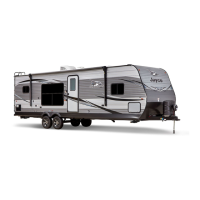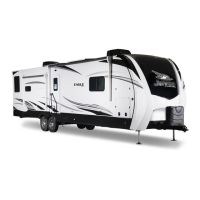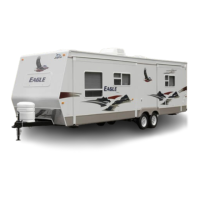29
storage periods. This condition is not likely to occur
except during storage situations when the inverter
cannot restore the battery charge.
Be sure to read, understand and follow the owner’s
information from the manufacturer of the combina-
tion CO/propane alarm. This includes information regarding
the limited life of the alarm.
Carbon monoxide (CO) is an insidious poison. It is a col-
orless, odorless and tasteless gas. Many cases of reported
carbon monoxide poisoning indicate while victims are aware
they are not well, they become so disoriented they are unable
to save themselves by either exiting the recreational vehicle
or calling for assistance. Young children and household pets
may be the rst aected.
Your combination carbon monoxide/propane alarm is de-
signed to detect the toxic carbon monoxide fumes that result from incomplete combustion,
such as those emitted from appliances, furnaces, replaces and auto exhaust.
A carbon monoxide/propane alarm is for other combustible gas,
re or smoke alarms. This carbon monoxide alarm is designed to detect carbon monoxide
gas from ANY source of combustion. It is not designed to detect smoke, re or any other
gas. Please note that there are hazards against which carbon monoxide detection may not be
eective, such as natural gas leaks or explosions.
This alarm is designed to sense the presence of carbon monoxide/propane gas, however
there are other combustible fumes or vapors that may be detected by the sensor including
(but not limited to): acetone, alcohol, butane and gasoline.
These chemicals can be found in commonly used items such as deodorants, colognes, per-
fumes, adhesives, lacquer, kerosene, glues, wine, liquor, most cleaning agents and the pro-
pellants of aerosol cans.
High temperatures can activate glue and adhesive vapors. If you close up a recreational
vehicle on a hot day, the chemicals used in its construction may be detected for months after
the vehicle was constructed (for more information, refer to Sec. 2, Formaldehyde).
Carbon monoxide/propane
alarm (alarm may vary from
model(s) shown)
Actuation of this detector indicates the presence of carbon monoxide
which can kill you.
Never turn the 12-volt battery disconnect control to the o position and
disconnect the battery cable to silence an alarm. The alarm will auto-
matically sense when the level of carbon monoxide in the air reaches
below dangerous levels. You should stay outside the vehicle in fresh
air until the alarm is silenced. When the alarm sounds, do not stand too
close to the alarm. The sound produced by the alarm is loud because it is
designed to wake a person in an emergency. Prolonged exposure to the
alarm at a close distance may be harmful to your hearing.

